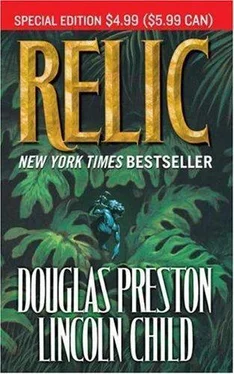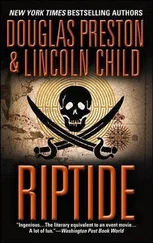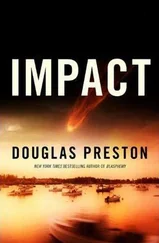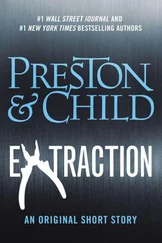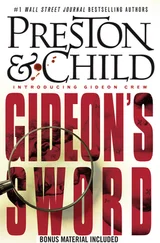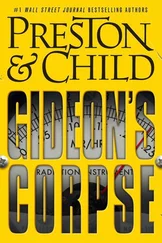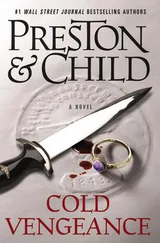Douglas Preston - Relic
Здесь есть возможность читать онлайн «Douglas Preston - Relic» весь текст электронной книги совершенно бесплатно (целиком полную версию без сокращений). В некоторых случаях можно слушать аудио, скачать через торрент в формате fb2 и присутствует краткое содержание. Жанр: Старинная литература, на русском языке. Описание произведения, (предисловие) а так же отзывы посетителей доступны на портале библиотеки ЛибКат.
- Название:Relic
- Автор:
- Жанр:
- Год:неизвестен
- ISBN:нет данных
- Рейтинг книги:3 / 5. Голосов: 1
-
Избранное:Добавить в избранное
- Отзывы:
-
Ваша оценка:
- 60
- 1
- 2
- 3
- 4
- 5
Relic: краткое содержание, описание и аннотация
Предлагаем к чтению аннотацию, описание, краткое содержание или предисловие (зависит от того, что написал сам автор книги «Relic»). Если вы не нашли необходимую информацию о книге — напишите в комментариях, мы постараемся отыскать её.
Relic — читать онлайн бесплатно полную книгу (весь текст) целиком
Ниже представлен текст книги, разбитый по страницам. Система сохранения места последней прочитанной страницы, позволяет с удобством читать онлайн бесплатно книгу «Relic», без необходимости каждый раз заново искать на чём Вы остановились. Поставьте закладку, и сможете в любой момент перейти на страницу, на которой закончили чтение.
Интервал:
Закладка:
Spec. No. 1899-1206
Maggie Lost Horse. Northern Cheyenne.
Spec. No. 1933-43469
Anasazi. Canyon del Muerto. Thorpe-Carlson expedition, 1900.
Spec. No. 1912-695
Luo. Lake Victoria. Gift of Maj. Gen. Henry Throckmorton, Bart.
Spec. No. 1872-10
Aleut, provenance unknown.
It was a strange graveyard indeed.
Beyond the storage area lay the warren of rooms housing the Physical Anthropology Lab. In earlier days, physical anthropologists had spent most of their time in this laboratory measuring bones and trying to determine the relationship between the races, where humanity had originated, and similar studies. Now, much more complex biochemical and epidemiological research was being done in the Physical Anthro Lab.
Several years earlier, the Museum—at Frock’s insistence—had decided to merge its genetics research and DNA laboratories with the lab. Beyond the dusty bone-storage area lay a spotless assortment of huge centrifuges, hissing autoclaves, electrophoresis apparatus, glowing monitors, elaborate blown-glass distillation columns, and titration setups—one of the most advanced technical facilities of its kind. It was in the [164] no-man’s-land between the old and the new that Greg Kawakita had set up shop.
Smithback looked through the tall racks of the storage room toward the lab doors. It was just after ten, and Kawakita was the only one around. Through the open shelves, Smithback could see Kawakita standing one or two rows over, making sharp, jerky overhead movements with his left hand, waving something about. Then, Smithback heard the zing of a line and the whirring of a fly reel. Well, raise my rent , Smithback thought. The man was fishing.
“Catch anything?” he called out loudly.
He heard a sharp exclamation and a clatter of a dropped rod.
“Damn you, Smithback,” Kawakita said. “You’re always sneaking about. This isn’t a good time to go around scaring people, you know. I might have been packing a .45 or something.”
He walked down his aisle and came around the corner, reeling in his fly rod and scowling good-humoredly at Smithback.
Smithback laughed. “I told you not to work down here with all these skeletons. Now look what’s happened: you’ve gone off the deep end at last.”
“Just practicing,” Kawakita laughed. “Watch. Third shelf. Buffalo Hump.”
He flicked the rod. The line whirred out, and the fly struck, then rebounded off a drawer on the third tier of a shelf at the end of the aisle. Smithback walked over. Sure enough: it contained the bones of someone who had once been Buffalo Hump.
Smithback whistled.
Kawakita drew in some line, loosely holding the loops in his left hand while he gripped the cork butt of the rod in his right. “Fifth shelf, second row. John Mboya,” he said.
Again the line arced through the air between the narrow shelves and the tiny fly ticked the correct label.
[165] “Izaak Walton, move over,” said Smithback, shaking his head.
Kawakita reeled in the line and started dismantling the bamboo rod. “It’s not quite like fishing on a river,” he said as he worked, “but it’s great practice, especially in this confined space. Helps me relax during breaks. When I don’t tangle my line in one of the cases, that is.”
When Kawakita was first hired by the Museum, he had declined the sunny fifth-floor office offered him, and instead claimed a much smaller one in the lab, saying he wanted to be closer to the action. Since then, he had already published more papers than some full curators had in their entire careers. His cross-disciplinary studies under Frock had quickly led him to an Assistant Curatorship in evolutionary biology, where he had initially devoted his time to the study of plant evolution. Kawakita skillfully used his mentor’s notoriety to advance himself. Lately, he had put aside plant evolution temporarily for the Genetic Sequence Extrapolator program. His only other passion in life, aside from his work, seemed to be fly-fishing; in particular, as he would explain to anyone who listened, his search for the noble and elusive Atlantic salmon.
Kawakita slid the rod into a battered Orvis case and leaned it carefully in a corner. Motioning Smithback to follow, he led the way down long rows of confined aisles to a large desk and three heavy wooden chairs. The desk, Smithback noticed, was covered with papers, stacks of well-thumbed monographs, and low trays of plastic-covered sand holding various human bones.
“Look at this,” Kawakita said, sliding something in Smithback’s direction. It was an engraved illustration of a family tree, etched in brown ink on hand-marbled paper. The branches of the tree were labeled with various Latin words.
“Nice,” said Smithback, taking a seat.
“That’s one word for it, I guess,” Kawakita replied.
[166] “A mid-nineteenth century view of human evolution. An artistic masterpiece, but a scientific travesty. I’m working on a little piece for the Human Evolution Quarterly about early evolutionary views.”
“When will it be published?” Smithback asked with professional interest.
“Oh, early next year. These journals are so slow.”
Smithback put the chart down on the desk. “So what does all this have to do with your current work—the GRE, or the SAT, or whatever it is?”
“G.S.E., actually.” Kawakita laughed. “Nothing whatsoever. This is just a little idea I had, some after-hours fun. I still enjoy getting my hands dirty from time to time.” He replaced the chart carefully in a binder, then turned toward the writer. “So, how’s the masterwork coming along?” he asked. “Is Madame Rickman still giving you a hard time?”
Smithback laughed. “Guess my struggles under the tyrant are common knowledge by now. But that’s a book in itself. Actually, I came by to talk to you about Margo.”
Kawakita took a seat across from Smithback. “Margo Green? What about her?
Smithback started paging aimlessly through one of the monographs scattered about the worktable. “I understand she needs your help on something.”
Kawakita’s eyes narrowed. “She called last night, asking if she could run some data through the Extrapolation program. I told her it wasn’t ready yet.” He shrugged. “Technically, that’s true. I can’t vouch one hundred percent for the accuracy of its correlations. But I’m terribly busy these days, Bill. I just don’t have the time to shepherd somebody through the program.”
“She’s not exactly some scientific illiterate you need to lead around by the nose,” Smithback replied. “She’s doing some heavy-duty genetics research of her own. You must see her around this lab all the time.” He pushed the monographs aside and leaned forward. “It [167] might not hurt to cut the kid a break,” he said. “It isn’t exactly an easy time for her. Her father died about two weeks ago, you know.”
Kawakita looked surprised. “Really? Is that what you were talking about in the staff lounge?”
Smithback nodded. “She hasn’t said much, but it’s been a struggle. She’s considering leaving the Museum.”
“That would be a mistake,” Kawakita frowned. He started to say something, then stopped abruptly. He leaned back in his chair and gave Smithback a long, appraising look. “This is a mighty altruistic gesture on your part, Bill.” He pursed his lips, nodding slowly. “Bill Smithback, the good Samaritan. New image for you, eh?”
“That’s William Smithback Jr. to you.”
“Bill Smithback, the Eagle Scout,” Kawakita continued. Then he shook his head. “Nope, it just doesn’t ring true. You didn’t really come down here to talk about Margo, did you?”
Читать дальшеИнтервал:
Закладка:
Похожие книги на «Relic»
Представляем Вашему вниманию похожие книги на «Relic» списком для выбора. Мы отобрали схожую по названию и смыслу литературу в надежде предоставить читателям больше вариантов отыскать новые, интересные, ещё непрочитанные произведения.
Обсуждение, отзывы о книге «Relic» и просто собственные мнения читателей. Оставьте ваши комментарии, напишите, что Вы думаете о произведении, его смысле или главных героях. Укажите что конкретно понравилось, а что нет, и почему Вы так считаете.
